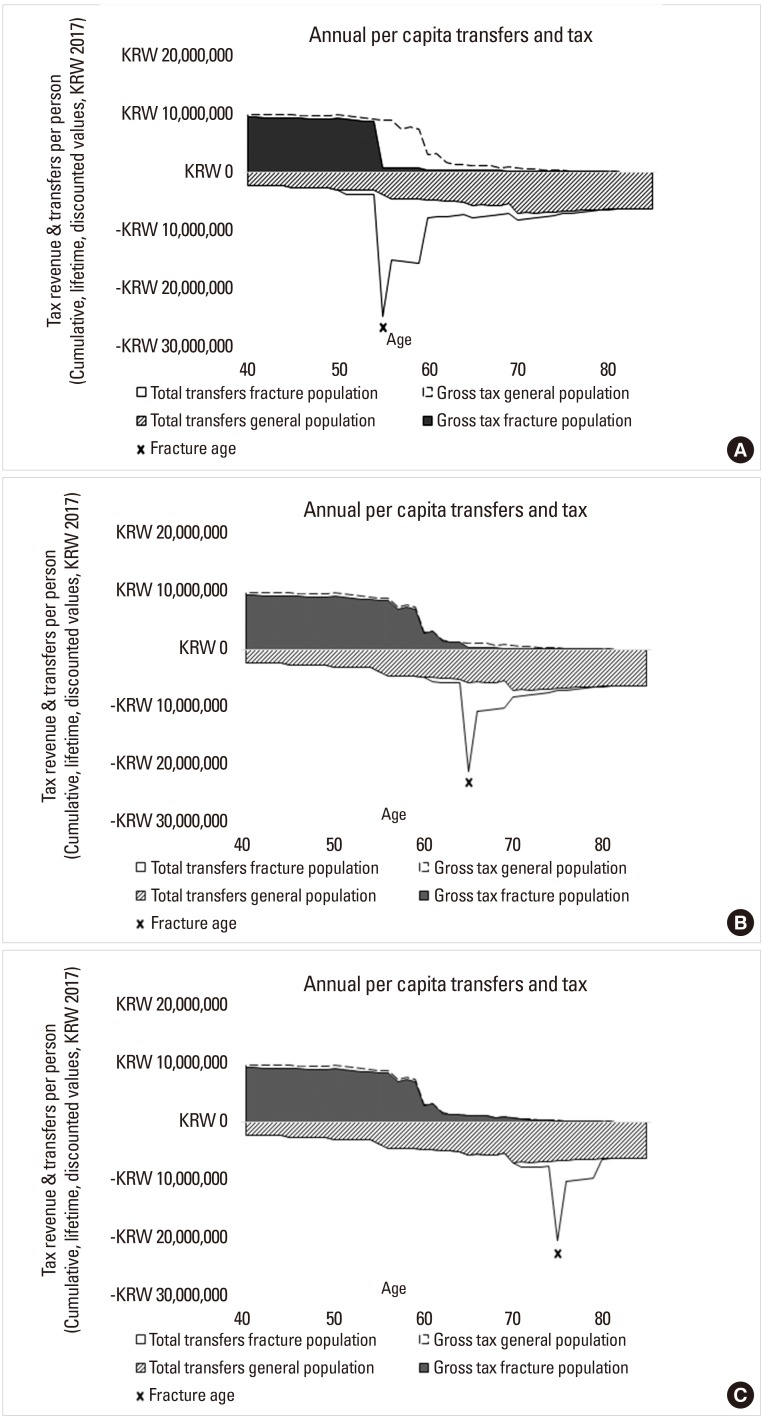1. The International Osteoporosis Foundation. Broken bones, broken lives: A roadmap to solve the fragility fracture crisis in Europe. Nyon, CH: The International Osteoporosis Foundation;2019.
2. Johnell O, Kanis JA. An estimate of the worldwide prevalence and disability associated with osteoporotic fractures. Osteoporos Int. 2006; 17:1726–1733. PMID:
16983459.

3. Goel A, Chen Q, Chhatwal J, et al. Cost-effectiveness of generic pan-genotypic sofosbuvir/velpatasvir versus genotype-dependent direct-acting antivirals for hepatitis C treatment. J Gastroenterol Hepatol. 2018; 33:2029–2036. PMID:
29864213.
4. Cheung CL, Ang SB, Chadha M, et al. An updated hip fracture projection in Asia: The Asian Federation of Osteoporosis Societies study. Osteoporos Sarcopenia. 2018; 4:16–21. PMID:
30775536.

5. Mithal A, Kaur P. Osteoporosis in Asia: a call to action. Curr Osteoporos Rep. 2012; 10:245–247. PMID:
22898971.

6. Lim S, Koo BK, Lee EJ, et al. Incidence of hip fractures in Korea. J Bone Miner Metab. 2008; 26:400–405. PMID:
18600408.

8. Korean Society for Bone and Mineral Research, National Health Insurance Service. Osteoporosis and osteoporotic fracture fact sheet. Seoul: Korean Society for Bone and Mineral Research, National Health Insurance Service;2018.
10. Cha HB. Public policy on aging in Korea. Geriatr Gerontol. 2004; 4:S45–S48.

11. Ha YC, Kim HY, Jang S, et al. Economic burden of osteoporosis in South Korea: Claim data of the national health insurance service from 2008 to 2011. Calcif Tissue Int. 2017; 101:623–630. PMID:
28913546.

12. Kim J, Lee E, Kim S, et al. Economic burden of osteoporotic fracture of the elderly in South Korea: A national survey. Value Health Reg Issues. 2016; 9:36–41. PMID:
27881257.

13. World Health Organization. Active ageing: A policy framework. Geneva, CH: World Health Organization;2002.
14. Kim S, So WY. Prevalence and correlates of fear of falling in Korean community-dwelling elderly subjects. Exp Gerontol. 2013; 48:1323–1328. PMID:
24001938.

15. Black DC. Working for a healthier tomorrow. London, UK: Crown Copyright;2008.
16. Connolly MP, Kotsopoulos N, Postma MJ, et al. The fiscal consequences attributed to changes in morbidity and mortality linked to investments in health care: A Government perspective analytic framework. Value Health. 2017; 20:273–277. PMID:
28237208.

17. Mauskopf J, Standaert B, Connolly MP, et al. Economic analysis of vaccination programs: An ISPOR good practices for outcomes research task force report. Value Health. 2018; 21:1133–1149. PMID:
30314613.

21. The Program on Global Aging, Health, and Policy, The Center for Economic and Social Research. Korean longitudinal study of aging. 2018. cited by 2018 Nov 27. Available from:
https://g2aging.org/?section=study&studyid=5.
23. Hyun KR, Kang S, Lee S. Population aging and healthcare expenditure in Korea. Health Econ. 2016; 25:1239–1251. PMID:
26085120.

25. Organisation for Economic Cooperation and Development. Pensions at a glance 2017: OECD and G20 Indicators. Paris, FR: OECD Publishing;2017.
27. Cho H, Byun JH, Song I, et al. Effect of improved medication adherence on health care costs in osteoporosis patients. Medicine (Baltimore). 2018; 97:e11470. PMID:
30045269.

28. Kwon JW, Park HY, Kim YJ, et al. Cost-effectiveness of pharmaceutical interventions to prevent osteoporotic fractures in postmenopausal women with osteopenia. J Bone Metab. 2016; 23:63–77. PMID:
27294078.

29. Alavinia SM, Burdorf A. Unemployment and retirement and ill-health: a cross-sectional analysis across European countries. Int Arch Occup Environ Health. 2008; 82:39–45. PMID:
18264715.

30. Qu B, Ma Y, Yan M, et al. The economic burden of fracture patients with osteoporosis in western China. Osteoporos Int. 2014; 25:1853–1860. PMID:
24691649.

31. Schofield D, Shrestha RN, Zeppel MJB, et al. Economic costs of informal care for people with chronic diseases in the community: Lost income, extra welfare payments, and reduced taxes in Australia in 2015-2030. Health Soc Care Community. 2019; 27:493–501. PMID:
30378213.

32. Tatangelo G, Watts J, Lim K, et al. The cost of osteoporosis, osteopenia, and associated fractures in Australia in 2017. J Bone Miner Res. 2019; 34:616–625. PMID:
30615801.

33. Eekman DA, ter Wee MM, Coupe VM, et al. Indirect costs account for half of the total costs of an osteoporotic fracture: a prospective evaluation. Osteoporos Int. 2014; 25:195–204. PMID:
24072405.

34. Bliuc D, Nguyen ND, Milch VE, et al. Mortality risk associated with low-trauma osteoporotic fracture and subsequent fracture in men and women. JAMA. 2009; 301:513–521. PMID:
19190316.

35. Lee YK, Jang S, Jang S, et al. Mortality after vertebral fracture in Korea: analysis of the National Claim Registry. Osteoporos Int. 2012; 23:1859–1865. PMID:
22109741.
36. Kotsopoulos N, Connolly MP. Is the gap between micro- and macroeconomic assessments in health care well understood? The case of vaccination and potential remedies. J Mark Access Health Policy. 2014; 1:2.

37. Dyer SM, Crotty M, Fairhall N, et al. A critical review of the long-term disability outcomes following hip fracture. BMC Geriatr. 2016; 16:158. PMID:
27590604.

38. Kim KW, Cho KJ, Kim SW, et al. A nation-wide, outpatient-based survey on the pain, disability, and satisfaction of patients with osteoporotic vertebral compression fractures. Asian Spine J. 2013; 7:301–307. PMID:
24353847.






 PDF
PDF ePub
ePub Citation
Citation Print
Print






 XML Download
XML Download